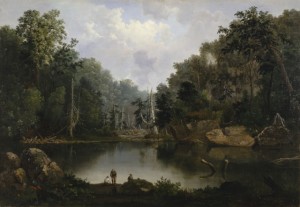“I have been in Rowe blinds many times without having a perfect evening or morning experience — until I had both in four days,” writes Lori Potter, who took this photo for the Kearney Hub. “On March 19, waves of cranes landed on river sandbars with an orange sunset in the background. Hundreds woke up in front of me at sunrise on Monday.” Read more
- Changing climate means sun might begin to set on sandhill cranes’ migration through Nebraska – Omaha.com: Hunting, Fishing And Outdoor Activities In Nebraska And Western Iowa | 031615
By David Hendee/World-Herald staff writer: “KEARNEY, Neb. — The migration clock that brings sandhill cranes to the same places at the same time along central Nebraska’s Platte River during the fading days of winter may be winding down. | A changing global climate could be a new headwind for sandhill cranes to battle in coming decades, according to the National Audubon Society. | “It’s hard to predict the future, of course, but there might not be as many sandhill cranes passing through Kearney,” said Joe Ryan, director of Audubon’s climate initiative. | Ryan is a featured speaker Saturday at Audubon’s Nebraska Crane Festival in Kearney. | Kearney bills itself as the “Sandhill Crane Capital of the World” because of its location near the epicenter of a 60-mile stretch of the Platte River that hosts an estimated 500,000 migrating cranes from mid-February to mid-April each year. | The experience of witnessing 80 percent of the world’s cranes feeding and loafing in fields and wet meadows or flying to and from river roosts attracts thousands of people. The birds’ prehistoric ka-ro-ro-ro call rolls up and down the river. Wind whooshes off wings of swirling flights of cranes buzzing sandbars and islands. It’s considered one of the continent’s greatest wildlife spectacles. | Fossil evidence indicates that migrating cranes have fed and rested in Nebraska for millennia on their way to nesting grounds in the tundra of North America and Siberia. But changes in what Ryan calls the “climate envelope” of temperature, precipitation, seasonal changes and other variables that cranes need to survive could tweak the birds’ environment enough to trigger noticeable alterations in migration patterns, he said.”
- Rowe Sanctuary | Audubon Nebraska
- Home | Crane Trust
- Peak Season For The Sandhill Crane Viewing | 032315
LINCOLN, Neb. It is peak season for viewing the cranes in the Grand Island area, Alda, Nebraska. | The cranes come to this area during migration season, which begins mid-February and continues through mid-April. Mid-March is when the Crane Trust Nature center explains, you see “peak numbers.” | The Platte River Valley is a pivotal stopping point for the cranes as it is a time when they can find a mate and also consume nutrients. | The Crane Trust Nature Center is a non-profit organization that seeks to protect and enhance the critical habitat of the cranes and other water birds.
- Let the sandhill crane viewing begin – Kearney Hub: Local 032015
Sandhill cranes land on Platte River sandbar roosts Thursday night west of Rowe Sanctuary’s Iain Nicolson Audubon Center southwest of Gibbon, including the three at right that got a drink before settling in for the night. After a late migration start because of ice storms between Nebraska and their wintering grounds in south Texas and Mexico, thousands of cranes now are arriving daily in the Kearney area, just in time for Audubon’s Nebraska Crane Festival, which runs through Sunday.
![A sandhill crane busts a move in a mating dance. Photo: Rick Rasmussen [WSJ 031315]](https://www.ghostturtles.com/wp-content/uploads/2015/03/sandhill_cranes_wsj_031315.jpg)
A sandhill crane busts a move in a mating dance. Photo: Rick Rasmussen [WSJ 031315]
How to Experience Nebraska’s Crane Migration
- Why Sandhill Cranes Are Worth a Trip to Nebraska – WSJ 031315
By Charu Suri: “As the sun appeared, the birds greeted the day in a deafening tidal wave of trills and cries that washed over us in an avian rite of spring lasting for at least 10 minutes. A surge of sandhill cranes flew toward us in dozens of V-shaped, chimerical formations. Some glided gracefully on air currents, some broke into ribbons and swooped down toward the sandbars in the middle of the river, while others veered away from the Platte to gobble up corn in nearby fields. The entire scene was accompanied by what sounded like countless chamber orchestras riffing simultaneously on Stravinsky.”
- Naturally Speaking: The sandhill crane migration shouldn’t be missed | Ames Tribune
Steve Lekwa: “We spent a gorgeous 70-degree evening watching cranes through binoculars and a spotter scope just a few miles southwest of Grand Island. We rejoined them before sunrise the next morning to watch the massed flocks head out to feed for the day. We were never out of sight or hearing of cranes the rest of the day as we explored back roads along the river and visited crane-themed nature centers. | The Crane Trust operates a visitor center just west of Grand Island and south of Interstate 80. They also manage a preserve of some 10,000 acres of critical crane habitat along the Big Bend area of the Platte River. The Rowe Sanctuary and Visitor Center is operated by the National Audubon Society and is southeast of Kearney. | We were lucky to spot a small flock of prairie chickens and numerous other species of ducks and geese during the day. A small flock of white fronted geese feeding in a cornfield near one of those back roads included a most unusual bird. The very small goose showed an entirely dark body and neck with some white on its rump but sported an entirely white face. It turned out to be a very rare dark color phase of the normally all white Ross goose, a small and uncommon snow goose look-alike that isn’t much bigger than a mallard duck.”
- Sometimes you hit a sandhill crane jackpot – Kearney Hub: Lori Potter 032715
“I have been in Rowe blinds many times without having a perfect evening or morning experience — until I had both in four days. On March 19, waves of cranes landed on river sandbars with an orange sunset in the background. Hundreds woke up in front of me at sunrise on Monday.”
- Craning toward Kearney – TheGazette (Cedar Rapids IA) 032815
Rich Patterson “We were in a blind — actually a huge plywood box — situated along the river at the Iain Nicolson Audubon Center. It’s also known as the Rowe Sanctuary and is just southeast of Kearney, Neb. | We had reservations and arrived 90 minutes before dawn. We checked in, enjoyed a brief introduction to cranes and were split into three groups of 30. A volunteer then led the groups out to the blind. | Everyone walked silently so as not to spook roosting cranes. Many were loaded down with binoculars, spotting scopes and cameras. Everyone was dressed warmly with coveralls or layers of pants and coats, thick socks and boots, long johns, hats and mittens. Even on this relatively mild morning, we knew we would chill quickly. | Reservations: Visit rowe.audubon.org or call (308) 468-5282 at the Iain Nicolson Audubon Center near Kearney, Neb.”
- Sandhill Cranes Described Poetically | Rosemary’s Blog 032615
Rosemary Washington: “Their beauty may lie beyond words, but as I was reading about sandhill cranes in preparation for my trip to Nebraska, I came across so many wonderfully descriptive and poetic passages by expert writers. Sometimes the writing was as lyrical and beautiful as the physical birds. While I was crane watching, it was rewarding to overlay my observations with these writers’ words.” | Paul Gruchow: “… the primeval sound rushed in, halfway between a croak and a song, the music of dry bones rattling. It surged and fell in a regular rhythm, like waves of water washing against a shore. . . . The sound of the sandhill cranes is like the roaring of the sea in a conch shell; when you have finally heard it, you recognize that you have always known it. It is like the cry of a loon or the howling of wolves or the warning rattle of a snake, an article in the universal language.”
![Sandhill cranes land on Platte River sandbar roosts west of Rowe Sanctuary’s Iain Nicolson Audubon Center southwest of Gibbon, Nebraska. [Photo by Lori Porter| Kearney Hub]](https://www.ghostturtles.com/wp-content/uploads/2015/03/sandhill_cranes_kearneyhub_032015.jpg)


![Sandhill cranes land on Platte River sandbar roosts west of Rowe Sanctuary’s Iain Nicolson Audubon Center southwest of Gibbon, Nebraska. [Photo by Lori Porter| Kearney Hub]](https://www.ghostturtles.com/wp-content/uploads/2015/03/sandhill_cranes_kearneyhub_032015-300x225.jpg)
![An endangered Whooping crane takes flight. Yhe large bird has a 7-foot wingspan. It is all white except for black wing tips and face markings. In this photo its long neck stretches forward; its wings sweep upward; and its black legs trail straight behind it. [Source: International Crane Foundation]](https://www.ghostturtles.com/wp-content/uploads/2023/03/Whooping-crane-eastern-ICF-080622-300x157.jpg)

![Mark Willis peruses a 1745 volume by Voltaire at a bouquiniste book stall on the banks of the Seine in Paris. He wears a brown leather jacket and checkered flat cap. He holds the open book in his hands. Rows of old books are seen on shelves behind him. [2005 photo by Ms. Modigliani]](https://www.ghostturtles.com/wp-content/uploads/2023/03/mw_bouquiniste_05-300x225.jpg)


